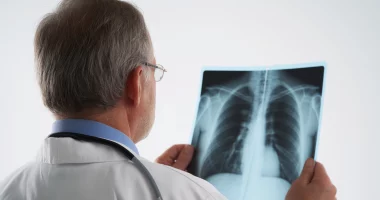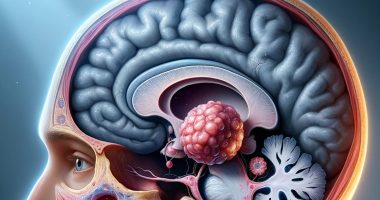Ulnar nerve neuropathy
Definition
Neuropathy of the ulnar nerve is a lesion of the n. ulnaris, different in etiology, accompanied by sensory and motor function impairment. It is manifested by weakness when trying to clench the hand into a fist and hold objects with the hand, lack of sensitivity of the skin of the V and partially IV fingers, atrophy of the hypotenor and small muscles of the hand, the appearance of the hand, similar to a clawed paw. The diagnosis of ulnar neuropathy relies on the results of neurological examination, electrophysiological testing, and radiography of bones and joints. Therapeutic tactics are built taking into account the genesis of neuropathy and may include both medication and physiotherapeutic methods and surgical treatment.
General information
Neuropathy of the ulnar nerve is a relatively common peripheral nervous system lesion. It often accompanies trauma to the elbow joint and, therefore, occurs not only in the practice of neurologists but also in specialists in the field of traumatology.
The anatomical location of the ulnar nerve is such that the most vulnerable place is its section localized near the elbow joint in the so-called cubital (ulnar) canal. In neurology, the symptom complex of ulnar nerve compression in this canal is called cubital canal syndrome. It occupies the second place among all neuropathies of compression genesis (the first place belongs to carpal tunnel syndrome – one of the variants of median nerve neuropathy).
Anatomy of the ulnar nerve
The nerve originates in the brachial plexus’s medial bundle (C7-C8, Th1). Without giving branches, it runs along the inner side of the shoulder and then passes to its posterior-medial surface. In the area of the elbow joint, it goes along the posterior surface of the inner epicondyle of the shoulder, where it is subcutaneous. It then enters the cubital canal, which is formed by the ulnar process, internal epicondyle, ligament, and tendons of the forearm muscles.
From the elbow to the wrist, the n. ulnaris runs along the medial edge of the inner surface of the forearm. ulnaris runs along the medial edge of the inner surface of the forearm. Here it gives motor branches to the medial portion of the finger flexor muscle and the ulnar flexor of the wrist. At the head of the ulna, the nerve gives a dorsal branch innervating the skin of the ulnar side of the back of the hand and the dorsal surface of the V, IV, and partially III fingers. Passing to the palm, n. ulnaris divides into superficial and deep branches. The first one is responsible for sensory perception of the skin of the little finger and the half of the ring finger facing it. The second branch is responsible for the innervation of the hand’s hypothenar muscles and small muscles, as well as joints, ligaments, and bones. After leaving the ulnar nerve, the deep branch passes through Guyon’s canal between the pea-shaped bone and the metacarpal palmar ligament.
Causes of ulnar nerve neuropathy
The most common mechanisms of ulnar neuropathy are traumatic nerve injury and compression of the nerve in the cubital canal. Nerve injury may be accompanied by: contusion of the hand, forearm dislocation, suprascapular fracture of the shoulder, fracture of the medial condyle of the shoulder, forearm fracture, isolated fracture of the ulna or fracture of the ulna, and dislocation of the hand. Cubital canal syndrome often occurs in people who are accustomed to doing elbow support. For example, resting the elbow on a desk, a machine, the edge of a car door, etc.
Nerve compression in the ulnar canal and Guyon’s canal is possible with inflammatory or anatomical changes in the structures that form these canals. Thus, compression neuropathy of the ulnar nerve can be observed in osteoma, ligament sprain, synovitis, tendovaginitis, deforming osteoarthritis, rheumatoid arthritis, osteodystrophy, bursitis of the elbow joint, posttraumatic arthrosis of the wrist joint and other diseases. Elbow neuropathy at the level of Guyon’s canal can be provoked by work associated with prolonged pressure from tools (screwdriver, hammer, scissors, pliers, etc.) in this area.
Symptoms of ulnar nerve neuropathy
Lesion of the n. ulnaris at the level of the cubital canal is characterized by weakness in the hand, manifested when trying to take something in the hand (e.g., lifting a kettle from the stove), playing the piano, typing on the keyboard, etc. Sensory disorders are manifested by numbness of the little finger, partially the ring finger, and the ulnar edge of the palm. Typical is a feeling of discomfort in the area of the elbow joint, often – pain in it, irradiating into the hand along the ulnar edge of the forearm. The above symptoms are often aggravated in the morning, which is associated with many patients’ habit of sleeping with their hands under the pillow or under the head and, therefore, bent in the elbow joints.
On examination, attention is drawn to hypotrophy of the hypotenor and small muscles of the palm, the position of the fingers as a clawed paw (the main phalanges are in a position of extension, and the middle phalanges are bent).
Elbow neuropathy in Guyon’s canal has similar manifestations. The difference is that pain syndrome is localized only in the area of the base of the hand and hypotenor, sensory disorders are present exclusively on the palm surface of the little finger and half of the ring finger, and the sensitivity of the back of the hand is completely preserved.
Diagnosis of ulnar nerve neuropathy
During the examination, the neurologist detects hypoesthesia of the V and adjacent half of the IV fingers; incomplete flexion of the V, IV, and partially III fingers when trying to gather the fingers into a fist; the presence of trigger points in the area of the medial epicondyle of the shoulder, along the course of the radial nerve or in the area of the pea bone. To assess the volume of movements in the hand, the patient is asked to place the hand with the palm on the table and, trying to keep it pressed against the table, try to “scratch” the table with the little finger and spread and close the fingers. Difficulty in performing these movements, as well as the previous symptoms, indicates ulnar neuropathy.
Electromyography and electroneurography help to clarify the topical lesion of the radial nerve. Ultrasound of the nerve allows you to establish the etiology of pathological changes underlying neuropathy and the degree of compression of the nerve in the canals. Analysis of the state of joints and bone structures is carried out according to the results of radiography of the elbow joint, radiography of the forearm and wrist joint, and, if necessary, CT of the joints is performed.
Neuropathy of the n. ulnaris should be differentiated from neuropathies of the median and radial nerves, polyneuropathy of various genesis, a radicular syndrome caused by the lesion of the lower cervical spine in osteochondrosis, myelopathy, spondyloarthritis, and other pathologies.
Treatment of ulnar nerve neuropathy
Treatment tactics for ulnar neuropathy depend primarily on the etiology of the nerve lesion. Surgical treatment is required to remove tumors, hematomas, and scars that compress the nerve trunk or cause compression of the musculoskeletal canal in which it passes. Surgical tactics are also used in the absence of proper effect from conservative treatment. Nerve decompression, neurolysis, release from adhesions, nerve transposition, removal of nerve tumors, and other operations are performed according to the indications.
Conservative therapy involves the prescription of anti-inflammatory drugs, analgesics, anticholinesterase drugs, vasoactive agents, and metabolites. It effectively complements drug treatment with physiotherapy. Combating muscle atrophy is carried out with the help of massage and electromyostimulation.
In the acute period of ulnar nerve neuropathy, an important point is the exclusion/limitation of static and dynamic loading, which increases the pathologic manifestations of the disease. Patients suffering from cubital canal syndrome are recommended to bandage a rolled-up towel to the flexor surface of the elbow during night sleep to limit arm flexion at the elbow.
All these treatment options are available in more than 980 hospitals worldwide (https://doctor.global/results/diseases/cubital-tunnel-syndrome). For example, Cubital tunnel syndrome surgery can be done in 46 clinics across Germany for an approximate price of $6.7 K (https://doctor.global/results/europe/germany/all-cities/all-specializations/procedures/cubital-tunnel-syndrome-surgery).

